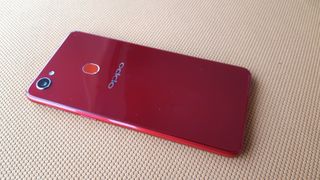Why you can trust TechRadar
Performance and software

The Oppo F7 has 4GB RAM and 64GB storage but it’s also available in a 6GB RAM and 128GB storage variant. It runs on Android Oreo 8.1 out-of-the-box with Oppo’s own ColorOS 5.0 layered on top.
ColorOS takes a while to get used to and it wouldn’t be so bad if Oppo had given more choices in the theme store. On the whole, the interface feels a little clunky.
For instance, Android phones normally allow you to swipe away a notification but Oppo requires you to submit a ‘delete’ confirmation after swiping left, which is entirely unnecessary.
The MediaTek Helio P60 chipset is what powers the Oppo F7. The same SoC can be found on the Oppo R15 as well. It has two sets of quad-cores in one package, high performance ARM Cortex A73s and power efficient Cortex-A53s.
The chipset also has dedicated AI processing to help with the phone’s facial recognition technology and real-time HDR.
MediaTek has the perception of only catering to budget smartphones but the Helio series makes one question the status quo. Vivo V9’s Snapdragon 626 didn’t seem as efficient in comparison to use. The camera app even managed to crash once or twice.
Both, the fingerprint sensor and face unlock, are quick to open the phone.The face unlock feature only works for unlocking the phone whereas fingerprints can used to secure apps and allocate internal storage.
Other than that you have the usual pin, password and pattern options. Another feature that plays into the security of the phone is the keyboard. The Oppo F7 offers its own secure keyboard which is layered on top the Gboard, claiming to keep your keystroke information private. Though the intention is noble, the keyboard doesn’t offer premium functionality. It’s unwieldy and feels heavy to use.
It’s also a recent trend to worry about what little ones can access on the phone. Apps have catered to this by creating subsidiaries like YouTube Kids and Facebook Messenger Kids.
The Oppo F7 has its own feature called ‘Kids Space’, which lets you disable apps that you don’t want children accessing.
The Oppo F7 even has its own stock apps on the device like its own app store and file manager. Nothing so impressive that it will make you switch over from the default apps you already use, but not so horrible that you’d ignore them entirely.
On-screen navigation keys aren’t for everyone and they can get a little annoying to use consistently, which why it’s nice that the Oppo F7 has the option to switch over to gestures. Once you enable the feature, the navigation keys at the bottom are replaced with horizontal markers.
The phone’s gaming experience wasn’t too bad either. It has the option of disable notifications while gaming and has something called ‘Game Acceleration’ that optimizes system functionality to enable better gameplay.
Battery

The Oppo F7’s battery life is pretty decent in comparison to the Vivo V9 and it manages to last through the day, but barely. This may be because usage patterns were a little heavier during the review. The fact that it doesn’t support fast charging was a drag as well, because default charging is fairly slow.
Current page: Performance, battery
Prev Page Introduction, price and design Next Page Camera, verdictPrabhjote Gill is the Senior Journalist at Business Insider India. She covering everything space, tech and defence at Business Insider India. She is also in-charge of allocating stories to junior writers.

Nikon Z 40mm f/2 review: this cheap, modern 'nifty forty' has been my every day lens for over a year and it hasn't let me down

Could ChatGPT be the next big cybersecurity worry — researchers say it can crack systems faster than ever before

Meta Quest's software is coming to new Asus ROG and Lenovo headsets
